+ Open data
Open data
- Basic information
Basic information
| Entry | Database: PDB / ID: 2xkx | ||||||
|---|---|---|---|---|---|---|---|
| Title | Single particle analysis of PSD-95 in negative stain | ||||||
 Components Components | DISKS LARGE HOMOLOG 4 | ||||||
 Keywords Keywords |  STRUCTURAL PROTEIN / STRUCTURAL PROTEIN /  SCAFFOLD PROTEIN / MEMBRANE ASSOCIATED GUANYLATE KINASE SCAFFOLD PROTEIN / MEMBRANE ASSOCIATED GUANYLATE KINASE | ||||||
| Function / homology |  Function and homology information Function and homology informationRHO GTPases activate CIT / positive regulation of AMPA glutamate receptor clustering / neuronal ion channel clustering / P2Y1 nucleotide receptor binding /  beta-1 adrenergic receptor binding / Neurexins and neuroligins / neuroligin family protein binding / receptor localization to synapse / positive regulation of neuron projection arborization / regulation of grooming behavior ...RHO GTPases activate CIT / positive regulation of AMPA glutamate receptor clustering / neuronal ion channel clustering / P2Y1 nucleotide receptor binding / beta-1 adrenergic receptor binding / Neurexins and neuroligins / neuroligin family protein binding / receptor localization to synapse / positive regulation of neuron projection arborization / regulation of grooming behavior ...RHO GTPases activate CIT / positive regulation of AMPA glutamate receptor clustering / neuronal ion channel clustering / P2Y1 nucleotide receptor binding /  beta-1 adrenergic receptor binding / Neurexins and neuroligins / neuroligin family protein binding / receptor localization to synapse / positive regulation of neuron projection arborization / regulation of grooming behavior / structural constituent of postsynaptic density / synaptic vesicle maturation / proximal dendrite / AMPA glutamate receptor clustering / cellular response to potassium ion / cerebellar mossy fiber / protein localization to synapse / vocalization behavior / LGI-ADAM interactions / neuron spine / Trafficking of AMPA receptors / beta-1 adrenergic receptor binding / Neurexins and neuroligins / neuroligin family protein binding / receptor localization to synapse / positive regulation of neuron projection arborization / regulation of grooming behavior / structural constituent of postsynaptic density / synaptic vesicle maturation / proximal dendrite / AMPA glutamate receptor clustering / cellular response to potassium ion / cerebellar mossy fiber / protein localization to synapse / vocalization behavior / LGI-ADAM interactions / neuron spine / Trafficking of AMPA receptors /  dendritic branch / Activation of Ca-permeable Kainate Receptor / juxtaparanode region of axon / neuron projection terminus / establishment or maintenance of epithelial cell apical/basal polarity / dendritic spine morphogenesis / negative regulation of receptor internalization / postsynaptic neurotransmitter receptor diffusion trapping / dendritic branch / Activation of Ca-permeable Kainate Receptor / juxtaparanode region of axon / neuron projection terminus / establishment or maintenance of epithelial cell apical/basal polarity / dendritic spine morphogenesis / negative regulation of receptor internalization / postsynaptic neurotransmitter receptor diffusion trapping /  frizzled binding / dendritic spine organization / frizzled binding / dendritic spine organization /  acetylcholine receptor binding / positive regulation of synapse assembly / RAF/MAP kinase cascade / Synaptic adhesion-like molecules / neurotransmitter receptor localization to postsynaptic specialization membrane / positive regulation of dendrite morphogenesis / acetylcholine receptor binding / positive regulation of synapse assembly / RAF/MAP kinase cascade / Synaptic adhesion-like molecules / neurotransmitter receptor localization to postsynaptic specialization membrane / positive regulation of dendrite morphogenesis /  beta-2 adrenergic receptor binding / regulation of neuronal synaptic plasticity / locomotory exploration behavior / cortical cytoskeleton / beta-2 adrenergic receptor binding / regulation of neuronal synaptic plasticity / locomotory exploration behavior / cortical cytoskeleton /  regulation of NMDA receptor activity / regulation of NMDA receptor activity /  social behavior / positive regulation of excitatory postsynaptic potential / AMPA glutamate receptor complex / social behavior / positive regulation of excitatory postsynaptic potential / AMPA glutamate receptor complex /  kinesin binding / neuromuscular process controlling balance / kinesin binding / neuromuscular process controlling balance /  excitatory synapse / excitatory synapse /  D1 dopamine receptor binding / Unblocking of NMDA receptors, glutamate binding and activation / D1 dopamine receptor binding / Unblocking of NMDA receptors, glutamate binding and activation /  glutamate receptor binding / positive regulation of protein tyrosine kinase activity / positive regulation of synaptic transmission / glutamate receptor binding / positive regulation of protein tyrosine kinase activity / positive regulation of synaptic transmission /  ionotropic glutamate receptor binding / ionotropic glutamate receptor binding /  extrinsic component of cytoplasmic side of plasma membrane / dendrite cytoplasm / extrinsic component of cytoplasmic side of plasma membrane / dendrite cytoplasm /  synaptic membrane / synaptic membrane /  PDZ domain binding / cell periphery / postsynaptic density membrane / regulation of long-term neuronal synaptic plasticity / PDZ domain binding / cell periphery / postsynaptic density membrane / regulation of long-term neuronal synaptic plasticity /  neuromuscular junction / establishment of protein localization / neuromuscular junction / establishment of protein localization /  cell-cell adhesion / cerebral cortex development / cell-cell adhesion / cerebral cortex development /  kinase binding / cell-cell junction / kinase binding / cell-cell junction /  synaptic vesicle / synaptic vesicle /  cell junction / positive regulation of cytosolic calcium ion concentration / chemical synaptic transmission / cell junction / positive regulation of cytosolic calcium ion concentration / chemical synaptic transmission /  postsynaptic membrane / postsynaptic membrane /  scaffold protein binding / postsynapse / basolateral plasma membrane / protein-containing complex assembly / scaffold protein binding / postsynapse / basolateral plasma membrane / protein-containing complex assembly /  protein phosphatase binding / protein phosphatase binding /  dendritic spine / dendritic spine /  postsynaptic density / neuron projection / postsynaptic density / neuron projection /  signaling receptor binding / signaling receptor binding /  dendrite / glutamatergic synapse / dendrite / glutamatergic synapse /  synapse / protein-containing complex binding / synapse / protein-containing complex binding /  protein kinase binding / protein kinase binding /  endoplasmic reticulum / endoplasmic reticulum /  membrane / membrane /  plasma membrane / plasma membrane /  cytosol / cytosol /  cytoplasm cytoplasmSimilarity search - Function | ||||||
| Biological species |   RATTUS NORVEGICUS (Norway rat) RATTUS NORVEGICUS (Norway rat) | ||||||
| Method |  ELECTRON MICROSCOPY / ELECTRON MICROSCOPY /  SOLUTION SCATTERING / SOLUTION SCATTERING /  single particle reconstruction / single particle reconstruction /  negative staining / Resolution: 22.9 Å negative staining / Resolution: 22.9 Å | ||||||
| Model type details | CA ATOMS ONLY, CHAIN A, B | ||||||
 Authors Authors | Fomina, S. / Howard, T.D. / Sleator, O.K. / Golovanova, M. / O'Ryan, L. / Leyland, M.L. / Grossmann, J.G. / Collins, R.F. / Prince, S.M. | ||||||
 Citation Citation |  Journal: Biochim Biophys Acta / Year: 2011 Journal: Biochim Biophys Acta / Year: 2011Title: Self-directed assembly and clustering of the cytoplasmic domains of inwardly rectifying Kir2.1 potassium channels on association with PSD-95. Authors: Svetlana Fomina / Tina D Howard / Olivia K Sleator / Marina Golovanova / Liam O'Ryan / Mark L Leyland / J Günter Grossmann / Richard F Collins / Stephen M Prince /  Abstract: The interaction of the extra-membranous domain of tetrameric inwardly rectifying Kir2.1 ion channels (Kir2.1NC(4)) with the membrane associated guanylate kinase protein PSD-95 has been studied using ...The interaction of the extra-membranous domain of tetrameric inwardly rectifying Kir2.1 ion channels (Kir2.1NC(4)) with the membrane associated guanylate kinase protein PSD-95 has been studied using Transmission Electron Microscopy in negative stain. Three types of complexes were observed in electron micrographs corresponding to a 1:1 complex, a large self-enclosed tetrad complex and extended chains of linked channel domains. Using models derived from small angle X-ray scattering experiments in which high resolution structures from X-ray crystallographic and Nuclear Magnetic Resonance studies are positioned, the envelopes from single particle analysis can be resolved as a Kir2.1NC(4):PSD-95 complex and a tetrad of this unit (Kir2.1NC(4):PSD-95)(4). The tetrad complex shows the close association of the Kir2.1 cytoplasmic domains and the influence of PSD-95 mediated self-assembly on the clustering of these channels. #1:  Journal: J Mol Biol / Year: 2003 Journal: J Mol Biol / Year: 2003Title: Supramodular structure and synergistic target binding of the N-terminal tandem PDZ domains of PSD-95. Authors: Jia-Fu Long / Hidehito Tochio / Ping Wang / Jing-Song Fan / Carlo Sala / Martin Niethammer / Morgan Sheng / Mingjie Zhang /  Abstract: PDZ domain proteins play critical roles in binding, clustering and subcellular targeting of membrane receptors and ion channels. PDZ domains in multi-PDZ proteins often are arranged in groups with ...PDZ domain proteins play critical roles in binding, clustering and subcellular targeting of membrane receptors and ion channels. PDZ domains in multi-PDZ proteins often are arranged in groups with highly conserved spacing and intervening sequences; however, the functional significance of such tandem arrangements of PDZs is unclear. We have solved the three-dimensional structure of the first two PDZ domains of postsynaptic density protein-95 (PSD-95 PDZ1 and PDZ2), which are closely linked to each other in the PSD-95 family of scaffold proteins. The two PDZs have limited freedom of rotation and their C-terminal peptide-binding grooves are aligned with each other with an orientation preference for binding to pairs of C termini extending in the same direction. Increasing the spacing between PDZ1 and PDZ2 resulted in decreased binding between PDZ12 and its dimeric targets. The same mutation impaired the functional ability of PSD-95 to cluster Kv1.4 potassium channels in heterologous cells. The data presented provide a molecular basis for preferential binding of PSD-95 to multimeric membrane proteins with appropriate C-terminal sequences. #2:  Journal: J Mol Biol / Year: 2000 Journal: J Mol Biol / Year: 2000Title: Solution structure and backbone dynamics of the second PDZ domain of postsynaptic density-95. Authors: H Tochio / F Hung / M Li / D S Bredt / M Zhang /  Abstract: The second PDZ domain of postsynaptic density-95 (PSD-95 PDZ2) plays a critical role in coupling N-methyl-D-aspartate receptors to neuronal nitric oxide synthase (nNOS). In this work, the solution ...The second PDZ domain of postsynaptic density-95 (PSD-95 PDZ2) plays a critical role in coupling N-methyl-D-aspartate receptors to neuronal nitric oxide synthase (nNOS). In this work, the solution structure of PSD-95 PDZ2 was determined to high resolution by NMR spectroscopy. The structure of PSD-95 PDZ2 was compared in detail with that of alpha1-syntrophin PDZ domain, as the PDZ domains share similar target interaction properties. The interaction of the PSD-95 PDZ2 with a carboxyl-terminal peptide derived from a cytoplasmic protein CAPON was studied by NMR titration experiments. Complex formation between PSD-95 PDZ2 and the nNOS PDZ was modelled on the basis of the crystal structure of the alpha1-syntrophin PDZ/nNOS PDZ dimer. We found that the prolonged loop connecting the betaB and betaC strands of PSD-95 PDZ2 is likely to play a role in both the binding of the carboxyl-terminal peptide and the nNOS beta-finger. Finally, the backbone dynamics of the PSD-95 PDZ2 in the absence of bound peptide were studied using a model-free approach. The "GLGF"-loop and the loop connecting alphaB and betaF of the protein display some degree of flexibility in solution. The rest of the protein is rigid and lacks detectable slow time-scale (microseconds to milliseconds) motions. In particular, the loop connecting betaB and betaC loop adopts a well-defined, rigid structure in solution. It appears that the loop adopts a pre-aligned conformation for the PDZ domain to interact with its targets. #3:  Journal: To be Published Journal: To be PublishedTitle: Structure of the Third Pdz Domain of Psd-95 Protein Complexed with Kketwv Peptide Ligand Authors: Saro, D. / Wawrzak, Z. / Martin, P. / Vickrey, J. / Paredes, A. / Kovari, L. / Spaller, M. #4:  Journal: Mol Cell / Year: 2001 Journal: Mol Cell / Year: 2001Title: Structure of the SH3-guanylate kinase module from PSD-95 suggests a mechanism for regulated assembly of MAGUK scaffolding proteins. Authors: A W McGee / S R Dakoji / O Olsen / D S Bredt / W A Lim / K E Prehoda /  Abstract: Membrane-associated guanylate kinases (MAGUKs), such as PSD-95, are modular scaffolds that organize signaling complexes at synapses and other cell junctions. MAGUKs contain PDZ domains, which recruit ...Membrane-associated guanylate kinases (MAGUKs), such as PSD-95, are modular scaffolds that organize signaling complexes at synapses and other cell junctions. MAGUKs contain PDZ domains, which recruit signaling proteins, as well as a Src homology 3 (SH3) and a guanylate kinase-like (GK) domain, implicated in scaffold oligomerization. The crystal structure of the SH3-GK module from PSD-95 reveals that these domains form an integrated unit: the SH3 fold comprises noncontiguous sequence elements divided by a hinge region and the GK domain. These elements compose two subdomains that can assemble in either an intra- or intermolecular fashion to complete the SH3 fold. We propose a model for MAGUK oligomerization in which complementary SH3 subdomains associate by 3D domain swapping. This model provides a possible mechanism for ligand regulation of oligomerization. | ||||||
| History |
|
- Structure visualization
Structure visualization
| Movie |
 Movie viewer Movie viewer |
|---|---|
| Structure viewer | Molecule:  Molmil Molmil Jmol/JSmol Jmol/JSmol |
- Downloads & links
Downloads & links
- Download
Download
| PDBx/mmCIF format |  2xkx.cif.gz 2xkx.cif.gz | 53.5 KB | Display |  PDBx/mmCIF format PDBx/mmCIF format |
|---|---|---|---|---|
| PDB format |  pdb2xkx.ent.gz pdb2xkx.ent.gz | 32.8 KB | Display |  PDB format PDB format |
| PDBx/mmJSON format |  2xkx.json.gz 2xkx.json.gz | Tree view |  PDBx/mmJSON format PDBx/mmJSON format | |
| Others |  Other downloads Other downloads |
-Validation report
| Arichive directory |  https://data.pdbj.org/pub/pdb/validation_reports/xk/2xkx https://data.pdbj.org/pub/pdb/validation_reports/xk/2xkx ftp://data.pdbj.org/pub/pdb/validation_reports/xk/2xkx ftp://data.pdbj.org/pub/pdb/validation_reports/xk/2xkx | HTTPS FTP |
|---|
-Related structure data
| Related structure data |  1761MC  1764C  1765C  1766C  2xkyC C: citing same article ( M: map data used to model this data |
|---|---|
| Similar structure data |
- Links
Links
- Assembly
Assembly
| Deposited unit | 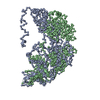
|
|---|---|
| 1 |
|
- Components
Components
| #1: Protein | Mass: 80203.047 Da / Num. of mol.: 2 / Mutation: YES Source method: isolated from a genetically manipulated source Source: (gene. exp.)   RATTUS NORVEGICUS (Norway rat) / Plasmid: PGEX-6P / Production host: RATTUS NORVEGICUS (Norway rat) / Plasmid: PGEX-6P / Production host:   ESCHERICHIA COLI (E. coli) / Strain (production host): BL21 / References: UniProt: P31016 ESCHERICHIA COLI (E. coli) / Strain (production host): BL21 / References: UniProt: P31016Compound details | ENGINEERED RESIDUE IN CHAIN A, THR 9 TO ALA ENGINEERED RESIDUE IN CHAIN A, GLU 23 TO LYS ENGINEERED ...ENGINEERED | |
|---|
-Experimental details
-Experiment
| Experiment |
| |||
|---|---|---|---|---|
| EM experiment | Aggregation state: PARTICLE / 3D reconstruction method:  single particle reconstruction single particle reconstruction |
- Sample preparation
Sample preparation
| Component | Name: RAT PSD-95 / Type: COMPLEX |
|---|---|
| Buffer solution | Name: 20MM TRIS/HCL, 5MM DTT, 1MM EDTA, / pH: 7.5 / Details: 20MM TRIS/HCL, 5MM DTT, 1MM EDTA, |
| Specimen | Conc.: 1 mg/ml / Embedding applied: NO / Shadowing applied: NO / Staining applied : YES / Vitrification applied : YES / Vitrification applied : NO : NO |
| EM staining | Type: NEGATIVE / Material: Uranyl Acetate |
| Specimen support | Details: CARBON |
-Data collection
| Microscopy | Model: FEI TECNAI 10 / Details: LOW DOSE | |||||||||||||||||||||||||||||||||||||||
|---|---|---|---|---|---|---|---|---|---|---|---|---|---|---|---|---|---|---|---|---|---|---|---|---|---|---|---|---|---|---|---|---|---|---|---|---|---|---|---|---|
| Electron gun | Electron source : TUNGSTEN HAIRPIN / Accelerating voltage: 100 kV / Illumination mode: FLOOD BEAM : TUNGSTEN HAIRPIN / Accelerating voltage: 100 kV / Illumination mode: FLOOD BEAM | |||||||||||||||||||||||||||||||||||||||
| Electron lens | Mode: BRIGHT FIELD Bright-field microscopy / Nominal magnification: 43000 X / Nominal defocus max: 2250 nm / Nominal defocus min: 900 nm / Cs Bright-field microscopy / Nominal magnification: 43000 X / Nominal defocus max: 2250 nm / Nominal defocus min: 900 nm / Cs : 3.6 mm : 3.6 mm | |||||||||||||||||||||||||||||||||||||||
| Specimen holder | Tilt angle max: 0.1 ° / Tilt angle min: 0 ° | |||||||||||||||||||||||||||||||||||||||
| Image recording | Film or detector model: GENERIC FILM | |||||||||||||||||||||||||||||||||||||||
| Image scans | Num. digital images: 2 | |||||||||||||||||||||||||||||||||||||||
| Radiation wavelength | Relative weight: 1 | |||||||||||||||||||||||||||||||||||||||
| Soln scatter |
|
- Processing
Processing
| EM software |
| |||||||||||||||
|---|---|---|---|---|---|---|---|---|---|---|---|---|---|---|---|---|
CTF correction | Details: PARAMETERS DETERMINED USING SCATTERING CURVE | |||||||||||||||
| Symmetry | Point symmetry : C1 (asymmetric) : C1 (asymmetric) | |||||||||||||||
3D reconstruction | Resolution: 22.9 Å / Num. of particles: 7854 / Nominal pixel size: 3.667 Å / Actual pixel size: 3.667 Å Details: THE COORDINATES DEPOSITED ARE FROM A COMBINED SAXS/EM STUDY. THE DOMAINS IN THE PROTEINS (HIGH RESOLUTION STRUCTURES FROM THE PDB) ARE POSITIONED RELATIVE TO ONE ANOTHER USING A SAXS CURVE, ...Details: THE COORDINATES DEPOSITED ARE FROM A COMBINED SAXS/EM STUDY. THE DOMAINS IN THE PROTEINS (HIGH RESOLUTION STRUCTURES FROM THE PDB) ARE POSITIONED RELATIVE TO ONE ANOTHER USING A SAXS CURVE, THIS COMPOSITE STRUCTURE IS THEN FITTED INTO AN EM MAP. DOMAINS PROVIDED BY X-RAY, NMR POSITIONED BY BUNCH ( PETOUKHOV, M. V. & SVERGUN, D. I. (2005). GLOBAL RIGID BODY MODELING OF MACROMOLECULAR COMPLEXES AGAINST SMALL- ANGLE SCATTERING DATA. BIOPHYS J 89, 1237-50.) REFINEMENT SUBMISSION BASED ON EXPERIMENTAL DATA FROM EMDB EMD-1761. (DEPOSITION ID: 7384). Symmetry type: POINT | |||||||||||||||
| Atomic model building | Protocol: RIGID BODY FIT / Space: REAL Details: METHOD--A MAP WAS GENERATED FROM THE SAXS MODEL COORDINATES AT A RESOLUTION MATCHING THE EXPERIMENTAL MAP. T HIS CALCULATED MAP WAS FITTED INTO THE EXPERIMENTAL MAP BY MAXIMIZING THE CROSS- ...Details: METHOD--A MAP WAS GENERATED FROM THE SAXS MODEL COORDINATES AT A RESOLUTION MATCHING THE EXPERIMENTAL MAP. T HIS CALCULATED MAP WAS FITTED INTO THE EXPERIMENTAL MAP BY MAXIMIZING THE CROSS-CORRELATION WITH THE EXPERIMENTAL MAP. THE COORDINATES WERE THEN REPLACED IN THE CALCULATED MAP TO GENERATE THE FINAL ENTRY. REFINEMENT PROTOCOL--DOCKED USING CHIMERA | |||||||||||||||
| Atomic model building |
| |||||||||||||||
| Refinement | Highest resolution: 22.9 Å | |||||||||||||||
| Refinement step | Cycle: LAST / Highest resolution: 22.9 Å
| |||||||||||||||
| Soln scatter model | Method: RIGID BODY MODELLING Conformer selection criteria: TWO MAJOR CONFORMERS WERE PRESENT IN THE POOL OF REFINED SAXS MODELS CHAIN A REPRESENTS THE BEST AGREEMENT WITH THE EXPERIMENTAL SAXS DATA (CHI=3.3). CHAIN B IS ...Conformer selection criteria: TWO MAJOR CONFORMERS WERE PRESENT IN THE POOL OF REFINED SAXS MODELS CHAIN A REPRESENTS THE BEST AGREEMENT WITH THE EXPERIMENTAL SAXS DATA (CHI=3.3). CHAIN B IS REPRESENTATIVE OF THE SECOND CONFORMATION (CHI=3.8). Details: NUMBER OF TIME FRAMES USED 24 (60S, 4.25M CAMERA), 40(60S, 1M CAMERA). PROTEIN CONCENTRATION 1 MG/ML (4.25M CAMERA) 8 MG/ML (1M CAMERA) Entry fitting list: PROGRAM PRE-BUNCH 1IU0/1QLC/1TP5/1KJW + SEQUENCE DATA Num. of conformers calculated: 20 / Num. of conformers submitted: 2 / Software author list: PETOUKHOV, M. V. & SVERGUN, D. I. / Software list: SASREF7/BUNCH8 |
 Movie
Movie Controller
Controller



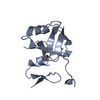
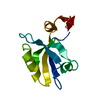
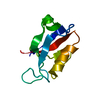

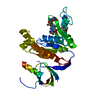
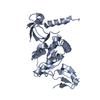
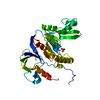
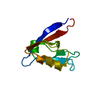
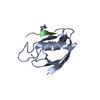
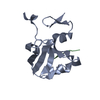

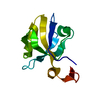
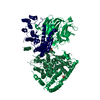
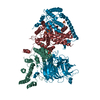
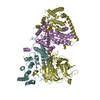
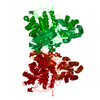
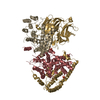
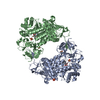
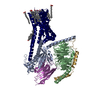
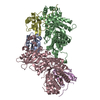
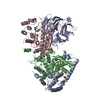

 PDBj
PDBj



